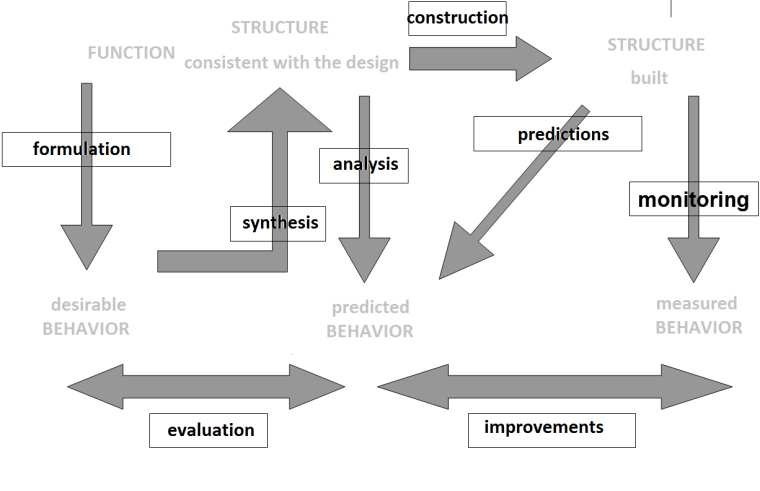Computer Aided Engineering
Construction, like other engineering fields, may be perceived and analysed from the perspective of the process of transforming information. One of the stages of this process is very well known – when we calculate the displacement of a beam, data about the structure (dimensions, material, load etc) is transformed into information about behaviour (such as displacement). Apart from these two types of information, there is also the information about the function of the structure; its design criteria, specifications, social expectations and so on.
Formulation
The first stage in the information transformation process is formulation – transforming information about functions into information about desired behaviours, in accordance with parameters such as safety, durability, stability, appearance and so on.
Synthesis
The second stage is synthesis. The parameters associated with the desired behaviour of the structure and loads are transformed into spatial information about the structure in accordance with the design. An example here is preliminary selection of foundations, as well as the type and size of load-bearing components.
Analysis
The third stage is analysis and assessment. After gathering information concerning the structure, we can analyse it to determine its expected behaviour (response). Most often, this information concerns the internal forces and displacements (deformation) caused by loads. These values are compared with the desired behaviours of the structure.
Many of the calculation methods used to analyse the structures are performed by computers. If the evaluation results are not satisfactory, the synthesis and analysis stages are repeated, or the formulation is changed. This is an iterative process. Designing is an iterative combination of synthesis and analysis, taking into account the formulation.
Construction
The next stage is construction – going from the design, to a built structure.
The last, stage is monitoring the built structure. If there is any uncertainty about the behaviour of the structure, monitoring can provide information about the third type of behaviour of structures – 'measured'. This comparison between the predicted and measured behaviours of a structure may lead to improvements in the structure or in the assessment techniques that have been used.
Image: Information flow in construction ( Original source: B. RAPHAEL, I.F.C. SMITH, Fundamentals of Computer Aided Engineering, Wiley, 2003.)
Computer Aided Engineering (CAE) therefore is the transformation between; information on functions; information on behaviours; and, information on the structure.
The text in this article is based on an extract from COMPUTER METHODS IN CONSTRUCTION, by Christoph Motzko, Florian Binder, Matthias Bergmann, Bogdan Zieliski, Mariusz Zabielski and Robert Gajewski. Darmstadt, Warsaw 2011. The original manual was developed within the scope of the LdV program, project number: 2009-1-PL1-LEO05-05016 entitled “Common Learning Outcomes for European Managers in Construction”. It is reproduced here in a slightly modified form with the kind permission of the Chartered Institute of Building.
[edit] Related articles on Designing Buildings
Featured articles and news
One of the most impressive Victorian architects. Book review.
RTPI leader to become new CIOB Chief Executive Officer
Dr Victoria Hills MRTPI, FICE to take over after Caroline Gumble’s departure.
Social and affordable housing, a long term plan for delivery
The “Delivering a Decade of Renewal for Social and Affordable Housing” strategy sets out future path.
A change to adoptive architecture
Effects of global weather warming on architectural detailing, material choice and human interaction.
The proposed publicly owned and backed subsidiary of Homes England, to facilitate new homes.
How big is the problem and what can we do to mitigate the effects?
Overheating guidance and tools for building designers
A number of cool guides to help with the heat.
The UK's Modern Industrial Strategy: A 10 year plan
Previous consultation criticism, current key elements and general support with some persisting reservations.
Building Safety Regulator reforms
New roles, new staff and a new fast track service pave the way for a single construction regulator.
Architectural Technologist CPDs and Communications
CIAT CPD… and how you can do it!
Cooling centres and cool spaces
Managing extreme heat in cities by directing the public to places for heat stress relief and water sources.
Winter gardens: A brief history and warm variations
Extending the season with glass in different forms and terms.
Restoring Great Yarmouth's Winter Gardens
Transforming one of the least sustainable constructions imaginable.
Construction Skills Mission Board launch sector drive
Newly formed government and industry collaboration set strategy for recruiting an additional 100,000 construction workers a year.
New Architects Code comes into effect in September 2025
ARB Architects Code of Conduct and Practice available with ongoing consultation regarding guidance.
Welsh Skills Body (Medr) launches ambitious plan
The new skills body brings together funding and regulation of tertiary education and research for the devolved nation.
Paul Gandy FCIOB announced as next CIOB President
Former Tilbury Douglas CEO takes helm.























